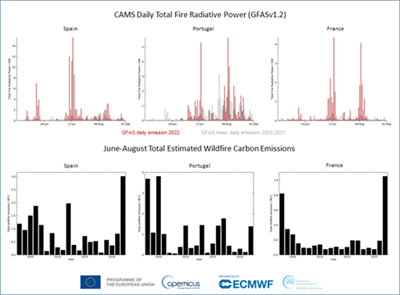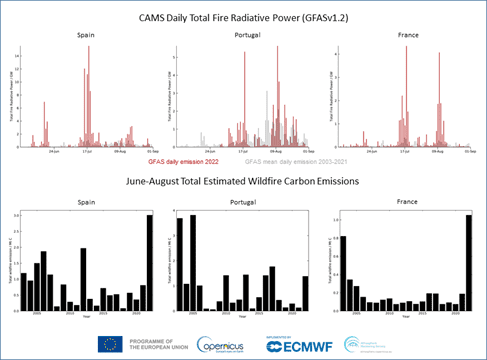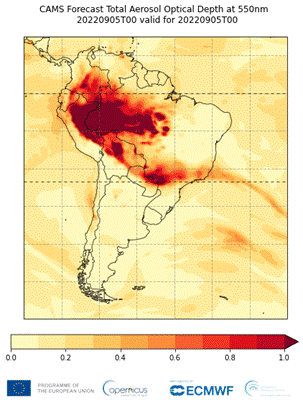CAMS GFAS Projected global annual carbon dioxide emissions from wildfires from 2003 to 2022 (as of December 10, 2022). Source: Copernicus Atmospheric Observing Service
The Copernicus Atmospheric Monitoring Service tracks emissions from wildfires around the world. In 2022, significant increases have been detected in some regions, while wildfires have seen decreases globally. Emissions from wildfires are a major source of air pollution, which deteriorates air quality and can pose health risks.
Copernicus Atmospheric Monitoring Service (CAMS)It is estimated that in 2022 (as of December 10) about 1455 megatons of carbon dioxide emissions were produced from wildfires and vegetation fires globally. This means a continued decrease in total global emissions and is associated with a decrease in savannah fires in the tropics. But the CAMS researchers also monitored several regions around the world, particularly parts of Europe and South America, where emissions were much higher than normal during peak wildfire season.
Comments Mark Barrington, Chief Scientist, CAMS: “Our monitoring of wildfires and vegetation fires shows that global emissions continue to decline in relation to land-use change and savannah fire declines in the tropics. However, we also continue to identify and monitor significantly increasing fire emissions Significant in different parts of the world, where warmer and drier conditions increase the risk of vegetation fires.” A more detailed description of our observations over the past year can be found here: Competence management system: Monitoring severe wildfire emissions in 2022.
Total bushfire emissions from the European Union and the United Kingdom between 1 June and 31 August 2022 were estimated to be the highest for these months since 2007. The increase in the length and intensity of heatwaves during the summer, combined with generally dry conditions on the continent in 2022 were factors Contribute.
Increasing emissions from wildfires in Europe have been of particular concern to some regions in France, Spain and Portugal. There, total emissions for the same period were the highest in the past 20 years and worsened local air quality. More information on European forest fires is available in this article.
Top row: Total daily CAMS GFAS fire radiative output for Spain, Portugal and France from June–August 2022 (red columns) compared to the 2003–2021 average (grey columns). Bottom row: CAMS GFAS total projected June-August CO2 emissions from wildfires for the same countries from 2003 to 2022. Source: Copernicus Atmospheric Monitoring Service.
Other regions that saw a significant increase in wildfire emissions this year were in North and South America. Between January and March, some areas in Paraguay and Argentina experienced it Record high emissions from wildfires for this time of year. In June and July, large, ongoing wildfires raged in Alaska, the Yukon, and the Northwest Territories in Canada, sending some of the smoke traveling to the Arctic Circle.
Meanwhile, the state of Amazonas in Brazil had the highest total emissions from July-August fires in the past 20 years. More information about wildfires in the Amazon over here.
A 5-day aerosol visual depth forecast was initialized for the CAMS over South America on September 5, 2022 at 00 UTC. Source: Copernicus Atmospheric Monitoring Service (CAMS)
The EFMS, implemented by the European Center for Medium-Range Weather Forecasts on behalf of the European Commission with funding from the European Union, monitors forest fires and their emissions throughout the year and provides data on the subject through the Global Fire Assimilation System (GFAS). . The system relies on satellite observations of active fires and the fire’s radiative power (FRP), a measure of fire intensity, to estimate carbon emissions and the wide range of air pollutants that make up smoke. In total, it provides a 20-year measurement series.
For more information on Global Wildfires Emissions 2022, see this Article.
For more information on how the CAMS tracks Wellfire emissions, you can see this Question and Answer.
About Copernicus and the ECMWF
Copernicus is part of the European Union’s space program, funded by the European Union, which is the flagship program for Earth observation. The company operates through six thematic services: Atmosphere, Marine, Land, Climate Change, Security and Emergencies. It offers freely available operational data and services that provide users with reliable and up-to-date information about our planet and its environment. The program is coordinated and managed by the European Commission and implemented in partnership with Member States, the European Space Agency (ESA), the European Organization for the Exploitation of Meteorological Satellites (EUMETSAT), the European Center for Medium Distance Weather Forecasts (ECMWF), EU agencies, Mercator Océan and others.
The ECMWF operates two services of the European Union’s Copernicus Earth Observing Programme: the Copernicus Atmospheric Monitoring Service (CAMS) and the Copernicus Climate Change Service (C3S). They also contribute to the Copernicus Emergency Management Service (CEMS), which is implemented by the European Union Joint Research Council (JRC). The European Center for Medium-Range Weather Forecasts (ECMWF) is an independent intergovernmental organization supported by 35 countries. It is a 24/7 operational and research institute that produces and disseminates digital weather forecasts to its member states. This data is fully available to the National Meteorological Services of the Member States. The supercomputer facility (and associated data archive) at the ECMWF is one of the largest of its kind in Europe and member states can use 25 percent of its capacity for their own purposes.
ECMWF has expanded the number of locations in which it operates. In addition to the UK headquarters and computing center in Italy, new offices focusing on activities carried out in partnership with the European Union, such as Copernicus, will be located in Bonn, Germany.
Copernicus Atmosphere Observing Service Networkhttp://atmosphere.copernicus.eu/
Copernicus Climate Change Networkhttps://climate.copernicus.eu/
More information about Copernicus:www.copernicus.eu
ECMWF website:https://www.ecmwf.int/
Twitter:
@employee
@tweet
@employee
#EUSpace
Media connection
Nuria Lopez
communication | Copernicus Contracts and the Press
General manager’s office
European Center for Medium-Range Weather Forecasts
Reading, UK | Bologna, Italy
Email: [email protected]
Phone: +44 (0) 118 949 9778
Mobile: +44 (0) 7392277523
Twitter: @employee
Bjorn Mogensen
Oxenstierna Communications
+46 708-184298
[email protected]
tags:

“Extreme tv maven. Beer fanatic. Friendly bacon fan. Communicator. Wannabe travel expert.”








More Stories
Which side does the government stand on bank fraud?
Qvantum has won the British Award for Heat Pump for Apartments
Tougher tax competition may lead to lower corporate taxes in the future – Economy – svenska.yle.fi